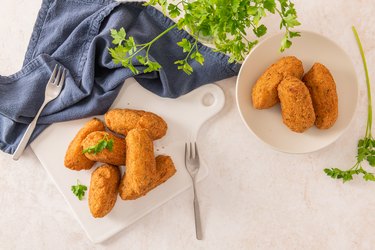
By the time the holidays roll around, buñuelos are all over Latin America. Their form and name vary slightly depending on the country in which you find yourself, but buñuelos are essentially sweet, fried-dough treats that swell in popularity and pop up in street food carts around Christmastime.
History of buñuelos
Video of the Day
The origin of buñuelos can be traced all the way back to the second century B.C. and a Mediterranean dough fritter recipe that called for frying balls of flour and cheese. The recipe was brought to what is presently known as Spain by the Moors, who migrated from North Africa to the Iberian Peninsula. Arab migrants from North Africa had a significant influence on the food and culture of the region, and buñuelos were no exception.
Video of the Day
When the Spanish colonized the Americas, settlers brought buñuelos along with them. From there, buñuelos evolved with cultures in Mexico, the Caribbean, and Central and South America, each putting their own spin on the pastry based on the ingredients available to them.
Buñuelos across the globe
Buñuelos come in all shapes and sizes and even names.
Most recipes use a wheat-based dough with anise seeds added for flavor. The dough is then rolled into thin pieces and deep fried, sometimes in the shape of a pancake and other times in a ball or a twist. Some countries top them with sugar or honey, while others fill them with jam, cream and cheese.
The differences across buñuelo recipes hinge upon the ingredients and crops native to that specific region. In Cuba, for example, the dough is made of yucca and malanga—root vegetables that are plentiful on the island—and is twisted into a figure eight and then topped with caramel. People in the Dominican Republic cover their yucca buñuelos with a cinnamon sugar syrup, and in Puerto Rico, buñuelos are small, round balls of starchy dough filled with cheese and ham or in guava, ground cinnamon or syrup flavored with anise seeds.
For Mexican buñuelos, bakers add yeast to the dough and top the crispy pancake-shaped buñuelo with warm piloncillo syrup, which is made of whole cane sugar. Some cut down on the prep time by using flour tortillas instead of the dough from scratch.
Uruguay is home to sweet and savory buñuelos. The sweet versions are made with apples and bananas, while the savory fritters are made with spinach, queso and seaweed. In Colombia, they also take a savory approach to their buñuelos, opting to make dough balls of cheese curd that they then fry in vegetable oil until golden brown.
Beyond Latin America
Filipinos have a take on buñuelos too due to their history of Spanish colonization. There, buñuelos—or bunwelos or binowilos, as they're also called—can be made of flour, rice or mashed banana and shaped like a ball, pancake or traditional doughnut. Turkey, the Netherlands, India and Russia also have their own versions of buñuelos.
Forming a tradition
Part of the magic of buñuelos and why they've become such a holiday staple is the fact that they're really affordable to make or purchase. However, that doesn't mean they're easy.
The process of making, molding and frying the dough can be laborious, inviting the help of a couple extra hands in the kitchen. With a rolling pin, all-purpose flour, paper towels and tongs for the frying, it's the perfect activity for the holidays. Whether you pick a Cuban, Mexican or Colombian recipe, try your hand at making buñuelos of your own this holiday season or to ring in the new year. Don't forget to enjoy them alongside tamales or a cup of hot chocolate.